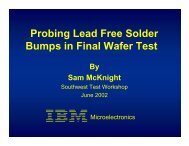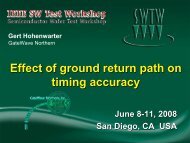Kelvin Contactors for Wafer-Scale Test - Semiconductor Wafer Test ...
Kelvin Contactors for Wafer-Scale Test - Semiconductor Wafer Test ...
Kelvin Contactors for Wafer-Scale Test - Semiconductor Wafer Test ...
You also want an ePaper? Increase the reach of your titles
YUMPU automatically turns print PDFs into web optimized ePapers that Google loves.
June 7-10, 2009<br />
San Diego, CA<br />
<strong>Kelvin</strong> <strong>Contactors</strong> <strong>for</strong><br />
<strong>Wafer</strong>-<strong>Scale</strong> <strong>Test</strong><br />
Jim Brandes<br />
Product Manager<br />
Everett Charles Technologies
Agenda<br />
• Two Growing <strong>Test</strong> Trends: <strong>Wafer</strong>-<strong>Scale</strong> & <strong>Kelvin</strong><br />
• <strong>Wafer</strong>-<strong>Scale</strong> has been Increasing in Popularity<br />
• <strong>Wafer</strong>-<strong>Scale</strong> Contacting a Challenge<br />
• Benefits of Spring Probes <strong>for</strong> <strong>Wafer</strong>-<strong>Scale</strong> <strong>Test</strong><br />
• <strong>Kelvin</strong>: Useful Tool <strong>for</strong> Final <strong>Test</strong><br />
• ECT’s Gemini <strong>Kelvin</strong><br />
• Gemini <strong>Kelvin</strong> Examples <strong>for</strong> <strong>Wafer</strong>-<strong>Scale</strong> <strong>Test</strong><br />
• Most <strong>Wafer</strong>-<strong>Scale</strong> Devices 0.5 & 0.4 mm Pitch<br />
• Finer-Pitch Version of Gemini <strong>Kelvin</strong> More<br />
Appropriate <strong>for</strong> <strong>Wafer</strong>-<strong>Scale</strong> <strong>Test</strong><br />
• Summary<br />
June 7 to 10, 2009<br />
IEEE SW <strong>Test</strong> Workshop 2
Two Growing <strong>Test</strong> Trends<br />
<strong>Wafer</strong>-<strong>Scale</strong> and <strong>Kelvin</strong> <strong>Test</strong><br />
• Each Presents Challenges<br />
• Greater Challenge Together<br />
• Spring Probes an Excellent<br />
Solution<br />
June 7 to 10, 2009<br />
IEEE SW <strong>Test</strong> Workshop 3
WST Increasingly Popular<br />
• <strong>Wafer</strong>-<strong>Scale</strong> <strong>Test</strong> is an Increasingly<br />
Popular <strong>Test</strong> Method<br />
• WST is Made Possible by Adding a<br />
Redistribution Layer to Dice<br />
• Redistribution Layer Effectively<br />
Packages the Die at the <strong>Wafer</strong> Level<br />
• Allows Final <strong>Test</strong> at <strong>Wafer</strong> Level<br />
• <strong>Wafer</strong>-<strong>Scale</strong> <strong>Test</strong> Presents<br />
Challenges <strong>for</strong> Contacting<br />
June 7 to 10, 2009<br />
Redistribution layer on WS device<br />
IEEE SW <strong>Test</strong> Workshop 4
WST a Contacting Challenge<br />
• Contact Must be Capable of<br />
Everything Required <strong>for</strong> Final <strong>Test</strong><br />
– High conductance <strong>for</strong> highcurrent<br />
tests<br />
– Low resistance <strong>for</strong> accurate<br />
voltage measurements<br />
– Low inductance <strong>for</strong> power and<br />
ground paths<br />
– High bandwidth <strong>for</strong> at-speed<br />
functional tests<br />
• <strong>Wafer</strong>-<strong>Scale</strong> Devices are<br />
Fine-Pitch BGA<br />
June 7 to 10, 2009<br />
Redistribution layer on WS device<br />
IEEE SW <strong>Test</strong> Workshop 5
Benefits of Spring Probes <strong>for</strong><br />
<strong>Wafer</strong>-<strong>Scale</strong> <strong>Test</strong><br />
• Final-<strong>Test</strong> Capable <strong>for</strong> Best Yields<br />
– High current <strong>for</strong> DC tests and power<br />
delivery<br />
– High bandwidth <strong>for</strong> RF tests<br />
– Low inductance <strong>for</strong> power delivery<br />
• Lowest Cost of Ownership<br />
– Lower initial price than Cantilever,<br />
buckling beam, membrane<br />
– Field repairable / rebuildable in the field<br />
without special tools<br />
June 7 to 10, 2009<br />
IEEE SW <strong>Test</strong> Workshop 6
<strong>Kelvin</strong>: Very Useful in Final <strong>Test</strong><br />
• Concept of Four-Wire Measurement Developed<br />
by Lord <strong>Kelvin</strong> over 100 Years Ago!<br />
• Eliminates Contact Resistance from DC<br />
Measurements<br />
• Essential <strong>for</strong> Accurate Voltage Force or<br />
Measure<br />
• Useful <strong>for</strong> R DSON and V DO , <strong>for</strong> Example<br />
i<br />
<strong>for</strong>ce<br />
<strong>for</strong>ce<br />
June 7 to 10, 2009<br />
Vm<br />
sense<br />
sense<br />
i sense<br />
<strong>Kelvin</strong> circuit diagram<br />
IEEE SW <strong>Test</strong> Workshop 7
Recognizing the Need <strong>for</strong> <strong>Kelvin</strong><br />
• Low Resistance Specifications. Examples:<br />
– RDSON (common low-R parameter):<br />
– Calculation required<br />
– Implied R=280 mΩ (280 mV / 1 A):<br />
• High Maintenance Requirements<br />
– Frequent probe cleaning<br />
– Short probe life<br />
– Indicate R C sensitivity – should be investigated<br />
June 7 to 10, 2009<br />
IEEE SW <strong>Test</strong> Workshop 8
<strong>Kelvin</strong> <strong>Test</strong> at <strong>Wafer</strong>-<strong>Scale</strong><br />
A Growing Need<br />
WLP 004-018 I/O Forecast<br />
2007<br />
2008<br />
2009<br />
2010<br />
2011<br />
2012<br />
CAGR<br />
Analog:<br />
Units (M)<br />
(%)<br />
Amps & Comp<br />
1838<br />
2054<br />
2243<br />
2517<br />
2743<br />
2990<br />
10.2<br />
Regulators<br />
3142<br />
3756<br />
4375<br />
5361<br />
6561<br />
8295<br />
21.4<br />
Data Conv.<br />
11<br />
12<br />
14<br />
17<br />
21<br />
25<br />
18.0<br />
Consumer<br />
483<br />
597<br />
732<br />
842<br />
960<br />
1089<br />
17.6<br />
Comm.<br />
38<br />
40<br />
43<br />
48<br />
54<br />
61<br />
9.8<br />
Computer<br />
24<br />
27<br />
30<br />
35<br />
39<br />
43<br />
13<br />
Other<br />
324<br />
362<br />
395<br />
435<br />
478<br />
526<br />
10.2<br />
Data courtesy Electronic Trend Publications<br />
June 7 to 10, 2009<br />
IEEE SW <strong>Test</strong> Workshop 9
BGAs Present Challenges<br />
<strong>for</strong> <strong>Kelvin</strong> contact<br />
Accuracy is Critical<br />
• Leaving Mark in Ball<br />
Apex Can Negatively<br />
Affect Solderability<br />
• Landing a Probe Too<br />
Close to Edge Can<br />
Cause Ball Shear<br />
• Decreasing Pitch<br />
Exacerbates Issues<br />
Pair of misaligned probes<br />
on 0.4 mm solder ball<br />
Probe pairs on<br />
0.65 mm BGA<br />
June 7 to 10, 2009<br />
IEEE SW <strong>Test</strong> Workshop 10
ECT’s Gemini <strong>Kelvin</strong><br />
• Gemini <strong>Kelvin</strong> in Use Since<br />
2007<br />
• Over 150 Designs, Over 700<br />
<strong>Contactors</strong> Shipped<br />
• Mostly In-Line (QFN/MLF)<br />
Designs<br />
• Hundreds of Thousands of<br />
Insertions per Contactor<br />
Gemini <strong>Kelvin</strong> probe pair<br />
June 7 to 10, 2009<br />
IEEE SW <strong>Test</strong> Workshop 11
Gemini <strong>Kelvin</strong> Probes Used<br />
<strong>for</strong> <strong>Wafer</strong>-<strong>Scale</strong> Contact<br />
• Actively Being Used in High-Volume<br />
Production <strong>Test</strong> Environments<br />
• Capable of Partial<br />
Arrays at 0.5 mm<br />
Pitch<br />
• Partial Arrays<br />
Around Perimeter<br />
at 0.4 mm Pitch<br />
0.4 mm pitch BGA with <strong>Kelvin</strong><br />
probe marks on two solder balls<br />
June 7 to 10, 2009<br />
IEEE SW <strong>Test</strong> Workshop 12
Example: Gemini <strong>Kelvin</strong><br />
Contactor<br />
• Quad Site<br />
• 16 BGA - 0.4 mm Pitch<br />
• Diagonal Sites<br />
• Optical Fiducials<br />
• Partial <strong>Kelvin</strong> – 5 of 16 balls<br />
June 7 to 10, 2009<br />
IEEE SW <strong>Test</strong> Workshop 13
Example: Gemini <strong>Kelvin</strong><br />
Contactor<br />
• Quad Site<br />
• 6 BGA - 0.5 mm pitch<br />
• Optical Fiducials<br />
• Partial <strong>Kelvin</strong> – 3 of 6 balls<br />
June 7 to 10, 2009<br />
IEEE SW <strong>Test</strong> Workshop 14
Example: Gemini <strong>Kelvin</strong><br />
Contactor<br />
Redistribution<br />
Board<br />
• Turnkey with Probe Card and Redistribution Board<br />
• Redistribution Board:<br />
• Allowed Existing Probe Card Design to be used<br />
• Achieved Customer-Required Minimum <strong>Test</strong> Height<br />
June 7 to 10, 2009<br />
IEEE SW <strong>Test</strong> Workshop 15
Gemini <strong>Kelvin</strong> probe pair<br />
Gemini <strong>Kelvin</strong><br />
Specifications<br />
Probe Pitch<br />
<strong>Kelvin</strong> Tip Spacing<br />
Board-side spacing<br />
<strong>Test</strong> Height<br />
Probe Compliance<br />
Force at <strong>Test</strong> Height<br />
Loop Inductance<br />
Bandwidth<br />
Contact Resistance<br />
Tip Styles<br />
Probe Finish<br />
Current Carrying Capacity<br />
0.4 mm and up (inline)<br />
0.65 and up full array; 0.4, 0.5 partial array<br />
0.1 mm minimum<br />
0.4 mm minimum<br />
3.22 mm<br />
0.44 mm total (0.26 mm DUT-side)<br />
25 – 30 g<br />
1.05 nH (single probe)<br />
0.65 nH (dual probe)<br />
-1dB @ 22 GHz (single probe @ 0.5 mm Pitch)<br />
-1dB @ 16 GHz (dual probe @ 0.5 mm Pitch)<br />
Need <strong>for</strong> Finer-Pitch<br />
<strong>Kelvin</strong><br />
0.5 mm Pitch<br />
June 7 to 10, 2009<br />
IEEE SW <strong>Test</strong> Workshop 17
Need <strong>for</strong> Finer-Pitch<br />
<strong>Kelvin</strong><br />
0.4 mm<br />
Pitch<br />
June 7 to 10, 2009<br />
IEEE SW <strong>Test</strong> Workshop 18
Fine-Pitch Gemini <strong>Kelvin</strong><br />
in Development<br />
• New, Finer-Pitch Probe has<br />
Capability to Accommodate Finer-<br />
Pitch BGAs<br />
– GMK is a scalable technology<br />
– Full BGA arrays at 0.4 mm pitch<br />
– Can be used in-line down to 0.3 mm pitch<br />
– DUT-side tips 0.08 mm spacing<br />
– Board-side tips 0.27 mm spacing<br />
June 7 to 10, 2009<br />
Fine-Pitch Gemini <strong>Kelvin</strong><br />
IEEE SW <strong>Test</strong> Workshop 19
Fine-Pitch Gemini <strong>Kelvin</strong><br />
in Development<br />
• Capable of Being Used With a<br />
Floating Alignment Plate (FAP)<br />
– <strong>Wafer</strong>-scale testing does not use FAP<br />
– Optical alignment eliminates the need<br />
<strong>for</strong> this mechanical alignment<br />
– FAP useful <strong>for</strong> contacting singulated<br />
packages<br />
– Packages can be tested in same<br />
contactor <strong>for</strong> consistency<br />
June 7 to 10, 2009<br />
Fine-Pitch Gemini <strong>Kelvin</strong><br />
IEEE SW <strong>Test</strong> Workshop 20
GMK030 in <strong>Wafer</strong> <strong>Scale</strong> <strong>Test</strong><br />
June 7 to 10, 2009<br />
IEEE SW <strong>Test</strong> Workshop 21
Issues to Overcome at Fine Pitch<br />
• Contactor Body Machining<br />
– Small, closely-spaced holes challenging:<br />
– Wall thickness<br />
– Aspect ratio<br />
– Might affect material choice<br />
Board-side tip<br />
Spacing 0.275 mm<br />
DUT-side tip<br />
Spacing 0.08 mm<br />
Fine-pitch Gemini <strong>Kelvin</strong> working height 2.45 mm<br />
June 7 to 10, 2009<br />
IEEE SW <strong>Test</strong> Workshop 22
Issues to Overcome at Fine Pitch<br />
• Board Fabrication<br />
– Probes placed at 45° to increase pitch<br />
– Results in 0.275 mm pitch<br />
– May require space trans<strong>for</strong>mer<br />
<strong>Kelvin</strong> pad pairs<br />
0.4 mm pitch Gemini <strong>Kelvin</strong><br />
Pattern, fanned out to 0.8 mm<br />
June 7 to 10, 2009<br />
IEEE SW <strong>Test</strong> Workshop 23
Summary<br />
Gemini <strong>Kelvin</strong><br />
Gemini <strong>Kelvin</strong> <strong>for</strong> BGA<br />
Fine-Pitch<br />
Gemini <strong>Kelvin</strong><br />
• <strong>Kelvin</strong> <strong>Test</strong> at <strong>Wafer</strong>-<strong>Scale</strong><br />
is a Growing Requirement<br />
• <strong>Kelvin</strong> at <strong>Wafer</strong>-<strong>Scale</strong><br />
Presents Contacting<br />
Challenges<br />
• Spring Probes are Available<br />
to Meet the Current Need<br />
• Further Spring Probe<br />
Development is Focused on<br />
Full <strong>Kelvin</strong> <strong>for</strong> Fine-Pitch<br />
<strong>Wafer</strong>-<strong>Scale</strong> <strong>Test</strong><br />
June 7 to 10, 2009<br />
IEEE SW <strong>Test</strong> Workshop 24








